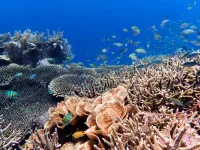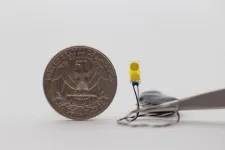How bright-light treatment improves sleep in stressed mice
A 3-step pathway passing through the habenula regulates non-REM sleep in chronic stress
2023-09-07
(Press-News.org) Chronic stress is associated with sleep disturbance. In their new study, Lu Huang and colleagues identify the neural pathway behind this behavior, and at the same time, explain how bright-light treatment is able to counter it. The research was conducted in mice at Jinan University in China and published September 7th in the open access journal PLOS Biology.
Bright-light treatment is known to improve sleep in those with sleep disorders, but how it works – and whether it works in cases of stress-induced sleep disturbances – was unknown. The researchers hypothesized that a part of the brain called the lateral habenula is deeply involved in this phenomenon because it both receives light signals from the eyes and can influence other parts of the brain that regulate sleep. To test this theory and fully characterize the neural pathway, the team performed a series of chemogenetic and optogenetic studies in a mouse model of chronic stress, which also showed irregular sleep. Specifically, chronic stress led to higher-than-normal amounts of non-REM sleep, which could be eliminated with bright-light treatment.
As hypothesized, the lateral habenula influenced the effects of stress on sleep. Its chemogenetic inhibition in stressed mice prevented the unusual high amounts of non-REM sleep, and on the flip side, its chronic activation in un-stressed mice resulted in extra non-REM sleep. Next, by separately activating habenular neurons that send signals to different regions of the brain, the researchers were able to identify the connection between the habenula and the rostromedial tegmental nucleus (RMT) as critical. Activating only these neurons mimicked the effects of stress on sleep, while inhibiting them in stressed mice mimicked the effects of bright-light treatment.
Lastly, the researchers showed that light-sensitive neurons in the lateral geniculate nucleus (LGN) naturally inhibit the habenula-RMT neurons, which explains why bright-light treatment can reduce stress-induced abnormalities in non-REM sleep. Understanding how bright-light treatment works can help devise optimal light treatments and perhaps pharmacological interventions targeting this pathway.
Coauthor Chaoran Ren adds, “A circuit mechanism has been identified that explains the effects of bright light treatment on sleep disruptions induced by chronic stress in mice.”
#####
In your coverage, please use this URL to provide access to the freely available paper in PLOS Biology: http://journals.plos.org/plosbiology/article?id=10.1371/journal.pbio.3002282
Citation: Huang L, Chen X, Tao Q, Wang X, Huang X, Fu Y, et al. (2023) Bright light treatment counteracts stress-induced sleep alterations in mice, via a visual circuit related to the rostromedial tegmental nucleus. PLoS Biol 21(8): e3002282. https://doi.org/10.1371/journal.pbio.3002282
Author Countries: China
Funding: This work was supported by STI2030-Major Projects (https://www.most.gov.cn/index.html) (2021ZD0203100 to CRR), National Natural Science Foundation of China (https://www.nsfc.gov.cn) (31922030, 32171010 and 31771170 to CRR; 32171009 to LH; 81870823 to XRS), Guangdong Basic and Applied Basic Research Foundation (http://gdstc.gd.gov.cn) (2023B1515040010 to CRR; 2021B1515020035 to LH), Science and Technology Program of Guangdong (http://gdstc.gd.gov.cn) (2018B030334001 to CRR), Science and Technology Program of Guangzhou (http://kjj.gz.gov.cn) (202007030012 to CRR), Young Elite Scientist Sponsorship Program By CAST (https://www.cast.org.cn) (YESS20210181 to LH), Guangzhou Health Science and technology project (http://wjw.gz.gov.cn) (202102010325 to XC), Programme of Introducing Talents of Discipline to Universities (http://www.moe.gov.cn) (B14036 to FKS). The funders had no role in study design, data collection and analysis, decision to publish, or preparation of the manuscript.
END
ELSE PRESS RELEASES FROM THIS DATE:
2023-09-07
A ‘near total’ lack of transparency is making it impossible to assess the quality of corporate-led ecosystem restoration projects, according to a Lancaster University-led study published today in Science.
Efforts to rebuild degraded environments are vital for achieving global biodiversity targets. The United Nations has launched a Decade on Ecosystem Restoration, and in recent years businesses around the world have collectively pledged to plant billions of trees, hundreds of thousands of corals and tens of ...
2023-09-07
An implantable sensor provided advanced warning of kidney transplant failure in rats as much as several weeks earlier than commonly used biomarkers of kidney function, researchers report. The device, tested in a rat model of kidney transplantation, provides real-time continuous monitoring of organ temperature and thermal conductivity, detecting inflammatory processes associated with graft rejection. Although lifesaving for patients with end-stage kidney disease, long-term kidney transplantation survival remains a major challenge. Graft failure ...
2023-09-07
In 2022, the eruption of the submerged Hunga Tonga–Hunga Ha apai volcano triggered a fast-moving and destructive underwater debris flow that severed telecommunication cables and reshaped the surrounding seafloor. The findings – representing some of the first fieldwork to document what happens when large volumes of erupted volcanic material are delivered directly into the ocean – provide new insights into the behavior and hazards of submerged volcanoes. Explosive volcanic eruptions on land create pyroclastic flows of hot ash and rock that, when they reach the ocean, can trigger damaging ...
2023-09-07
Large transnational corporations (TNCs) are positioning themselves as environmental leaders, carrying out environmental restoration projects that go beyond their legal obligations. However, some corporations oversell their efforts. In this Policy Forum, Timothy Lamont and colleagues present an evaluation of sustainability reports of 100 of the world’s largest businesses, revealing the extent to which TNCs are claiming to contribute to, but failing to report on, ecosystem restoration. “Increased rigor, consistency, transparency, and accountability are needed to ensure that corporate-led restoration delivers quantifiable, ...
2023-09-07
In 2021, more than 400 million metric tons of plastic waste were produced worldwide, and it is predicted that the world’s plastic waste growth will continue to outpace the efforts to reduce plastic pollution in the coming decades. As food delivery services became increasingly popular during the COVID-19 pandemic, the surge in plastic waste generated by single-use cutlery has become a key environmental challenge for many countries. A new study finds “green nudges” that encouraged customers to skip asking for cutlery with their delivery orders were dramatically successful and could be a powerful policy tool to reduce plastic waste.
“Few policies target plastic waste ...
2023-09-07
A body can reject a transplanted organ at any time — even decades later
Signs of rejection must be caught early to intervene, preserve the organ
Current monitoring methods are intermittent, imperfect and sometimes invasive
New implant offers continuous monitoring by tracking the organ’s temperature
When temperatures change, an alert is sent to a smartphone or tablet in real time
EVANSTON, Ill. — Northwestern University researchers have developed the first electronic device for continuously monitoring ...
2023-09-07
Who can forget the stomach-churning moments when “Survivor” contestants forced down crunchy insects, among other unappetizing edibles, for a chance to win $1 million? In daring culinary challenges, the TV show’s contestants exhibited gastronomic bravery as viewers watched in discomfort.
Digesting a crunchy critter starts with the audible grinding of its rigid protective covering — the exoskeleton. Unpalatable as it may sound, the hard cover might be good for the metabolism, according to a new study, in mice, from Washington University School of Medicine ...
2023-09-07
People who primarily use their own gut feeling to determine what is true and false are more likely to believe conspiracy theories. That is the conclusion of researchers at Linköping University, Sweden, who have investigated the relationship between susceptibility to misleading information and the conviction that the truth is relative.
“I think many people who emphasise a more relativistic view of what truth is mean well. They believe that it’s important that everyone should be able to make their voice heard. But these results show that such a view can actually be quite dangerous,” says PhD student ...
2023-09-07
DALLAS and Al Mubarraz, Kingdom of Saudi Arabia, September 7, 2023 — Almoosa Specialist Hospital, in Al Ahsa, Saudi Arabia has been recognized by the American Heart Association, the world's leading nonprofit organization focused on heart and brain health for all, as a the first Comprehensive Chest Pain Center in the country. This designation signifies the hospital’s status as a critical element in the kingdom’s effort to create a system of healthcare that seeks to save lives in Saudi Arabia by closing the gaps ...
2023-09-07
September 7, 2023 – A growing body of evidence suggests that psychedelic drugs may be useful in treating various mental health conditions. However, many challenges remain in defining their clinical benefits and overcoming the complex regulatory obstacles to their use. The September issue of Journal of Psychiatric Practice presents a research review and update on therapeutic use of psychedelics – focusing on the use of psilocybin for treatment of depression. The journal is published in ...
LAST 30 PRESS RELEASES:
[Press-News.org] How bright-light treatment improves sleep in stressed mice
A 3-step pathway passing through the habenula regulates non-REM sleep in chronic stress


